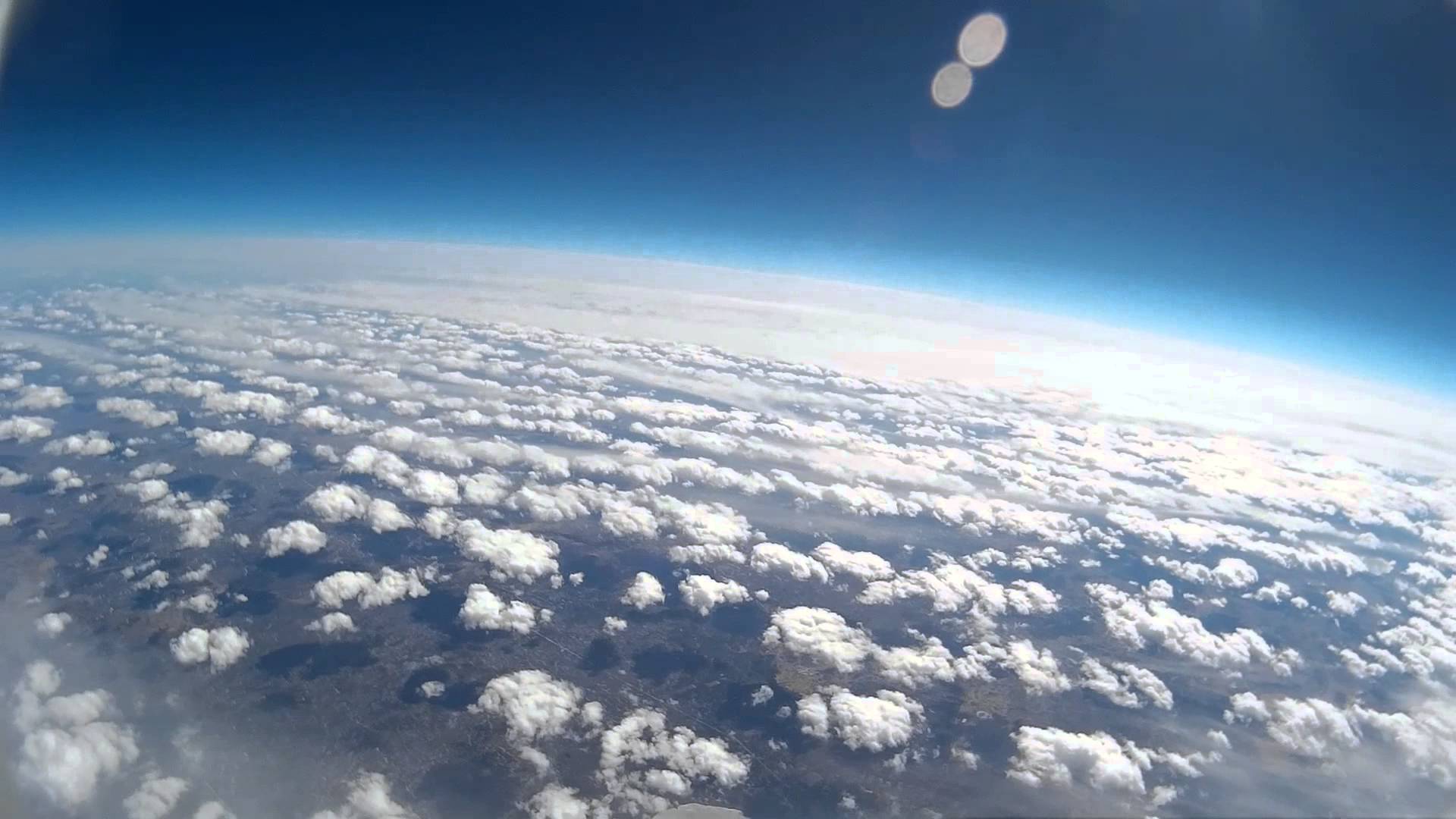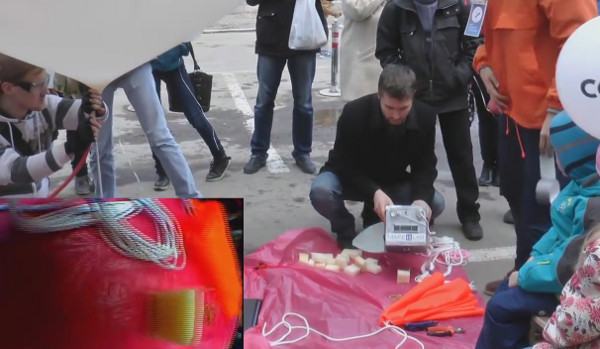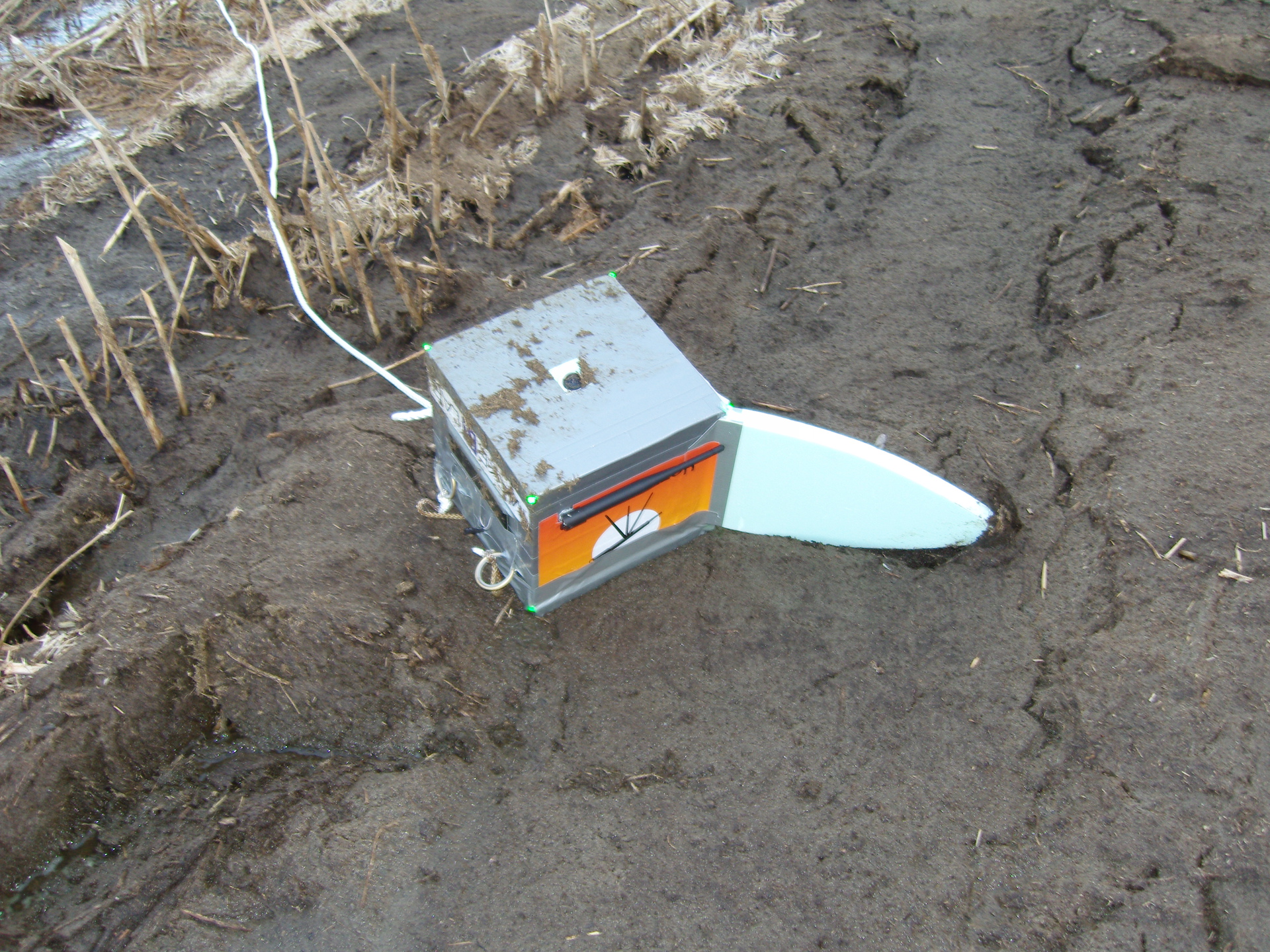How we launched the weather probe in the Urals. Part 1
 Running a weather probe into the sky is an old-time fun for scientists and enthusiasts, since the incident in Roswell, New Mexico. Meteorologists launch probes to monitor the processes in the upper atmosphere. Someone launches probes in a tornado to find out its structure. Enthusiasts, for the most part, do it for a beautiful picture of our home planet from the height of the flight of Francis Gary Powers.
Running a weather probe into the sky is an old-time fun for scientists and enthusiasts, since the incident in Roswell, New Mexico. Meteorologists launch probes to monitor the processes in the upper atmosphere. Someone launches probes in a tornado to find out its structure. Enthusiasts, for the most part, do it for a beautiful picture of our home planet from the height of the flight of Francis Gary Powers.Our hackspace is full of enthusiasts, and it was only a matter of time when we would hold such a grand event. This time has come in the spring of this year. On a cool morning on April 11, 2015, the MakeItLab hackspace, along with the network of Four Eyes optics stores and several other organizations, launched a weather probe into the “Ural” stratosphere!
I must say, we decided to make a good show out of the launch, and organized a direct video link from the probe to the big TV. A bunch of schoolchildren were able to observe themselves from above, from the height of the flight of the rapidly receding airborne apparatus. It was very cool! Of course, on board was the usual action camera, which captured the beauty of near-space. Finally, we filmed our march shot at 200 km behind the fallen probe. All this read / look under the cut.
How it all began
Almost a year ago, our hackspace was visited by Alexander Izgagin, the head of the local planetarium, and offered to launch a weather probe together. He brought a bunch of already purchased equipment, including two cylinders. It remains only to put everything together, decide on the payload, extract helium, and launch the device into the sky.
')
It was then that the main goal of the launch was formulated - the popularization of science. For this purpose it was supposed to collect a lot of schoolchildren on the launch itself. Arrange among the guys a competition for the best research that can be carried out on board the probe. Send something memorable to the stratosphere.
But, unfortunately, while we were slowly preparing to launch, the cold and snow crept in unnoticed. So it was decided to postpone the event in the spring of 2015. In addition, in the spring there is also a wonderful holiday - the day of astronautics. It was to this date that we planned a solemn launch. It remains only to finish the job!
What is the weather probe
 Before proceeding with the design, we carefully studied the "Internet", and in particular the experience of our colleagues from St. Petersburg. We learned how and from what to create a weather probe, as they say, with their own hands. So we found out that the classical amateur weather probe circuit consists of three main parts:
Before proceeding with the design, we carefully studied the "Internet", and in particular the experience of our colleagues from St. Petersburg. We learned how and from what to create a weather probe, as they say, with their own hands. So we found out that the classical amateur weather probe circuit consists of three main parts:- helium balloon;
- parachute;
- payload.
All these parts are connected by a file - a rope made of light but durable material. The length of the cargo to the parachute was about 10 meters long. The length of the parachute to the ball is 5 meters.
Cylinder and piping
Weather probes rise into the air due to the Archimedean force pushing a balloon with a light gas into the upper rarefied layers of the atmosphere. Hydrogen or helium is commonly used as a light gas. The first gives a lot of traction, but in a mixture with air is very explosive (remember Hindenburg). The second is an inert gas, therefore it does not burn, but also gives less craving. Since we are going to launch a probe among a pile of children, the choice fell on helium.
We used a chloroprene ball, widely used for promotional purposes. Actually, we bought it in the appropriate organization. Judging by the specification, the maximum volume of an 8-foot ball was 7.5 cubic meters. meters The maximum recommended load weight is 4.5 kg. That's how it looked in its original state. Like a giant balloon.

Parachute
There are two common parachute mounting schemes. In the first, the halyard from the load to the ball is continuous, and the parachute with the balancing ring, as if branched off from the halyard, and freely dangles. In the second, the halyard is divided into two segments, the first of which clings to the center of the balancing ring, and the second to the top of the parachute. We chose the second option.
The balance ring was drawn in SketchUp, and printed out by PLA plastic on a 3D printer. The parachute was cut from a piece of tarpaulin 1x1m. They attached eight lines to it, and made a hole in the center. All edges, of course, processed. Here is the folded parachute and ring:

The idea of such a scheme is simple. While the device takes off, the parachute is in a tense state, and serves as part of the halyard. As soon as the ball bursts, the parachute loses its tension and begins to finish.
Instrument compartment
Based on world experience and our Wishlist, we decided to place the following equipment in a flying cube:
1) GPS GSM tracker domestic company X-Keeper. A GPS tracker is a device that every N minutes sends its position coordinates via a GPS network. In this particular device were the sims of our two largest operators. In order for the tracker to help, the ash tree is a stump, the descent vehicle must fall within the network of one of the operators.
2) Light and sound beacon with autonomous power. A few hours after the start, this device begins to howl and blink in alarm with bright LEDs. This should simplify the search a little, especially in the dark. In fact, a simple handkerchief on an MSP430 energy-efficient microcontroller.
3) SJ4000 HD camera on the side of the module was destined to shoot the beauty of our planet from beyond the clouds.
4) A camera in the floor of the module and a 500mW 1.2GHz radio transmitter were intended for online broadcast during takeoff.
5) The unit for collecting sensor readings — sort of a logger — we set up to measure flight altitude, temperature, and humidity. In addition, a small solar battery was glued on board, which was also connected to the logger.
6) LiPO battery with a capacity of 2200 mAh and a voltage of 3S (11.1V) - to power all this outrage.
7) Special cargo - 12 jubilee coins with the image of Yuri Gagarin, and a handful of all sorts of important things, including children's toys and toffee.
In more detail about the probe equipment we will write in the next article, but for now here is a diagram of what is connected with what.

The module itself was assembled from a thermal insulation material with a thickness of 30 mm. Extruded polystyrene, which is sold in every hardware store. The box was carefully glued to Uhu Por with glue and wrapped in reinforced tape. It turned out this box:

The weight of the weather probe, including the ball itself, the halyard, the parachute, and the instrument compartment was about 2 kg. Considering that we planned to fill the balloon with 5 cubic meters of helium, the probe should have flown at a decent speed of 5 m / s.
Photo of probe equipment
GPS tracker:

FPV Camera:

Camera Transmitter:

SJ4000 HD Camera:

Light and sound beacon assembled in haste:

The lower online camera was placed in a printed case on a 3D printer. Armored glass did not put in order not to provoke the appearance of dew.


FPV Camera:

Camera Transmitter:

SJ4000 HD Camera:

Light and sound beacon assembled in haste:

The lower online camera was placed in a printed case on a 3D printer. Armored glass did not put in order not to provoke the appearance of dew.

Ground equipment
To ensure the broadcast of video from the probe, they used such a receiver and a directional antenna to it. By the way, thanks to this antenna, we managed to shoot video from a distance of several kilometers.


A helium balloon was purchased from a local technical gas supplier. In a similar office, mined and gearbox for the cylinder. I must say, without a gearbox to pump the ball will not be easy. When unscrewing the valve on the cylinder, the gas will popret very vigorously, and it will be easy to tear the ball. All observers at the same time will be filled with merry dwarf laughter.
Launch permission
Of course, you can try to launch a weather probe somewhere outside the city without permission. But if you only think about what this probe could do in the tense airspace above modern cities, it immediately becomes uncomfortable. To do everything right, we were concerned in advance about obtaining permission from the competent services. It all started not very much. The police, the FSB, the Ministry of Emergency Situations, the administration - all denied our request, and redirected to each other.
As it turned out later, the launch service of the meteo-probes is a service with a long name: the zone center of the unified air traffic management service (abbreviated ETS ATM). There we were asked to write an official request to launch a weather probe, indicating the flight characteristics, as well as the exact date and time of launch. Next, on day X, we had to notify the service of our readiness, and report the calculated coordinates of the fall of the probe. What we did, using the predict service predict.habhub.org . Finally, after the apparatus crashed, it was necessary to call again and report the completion of the mission.
1 hour before the start
So, everything is ready to launch a weather probe. We take out the equipment on the launch pad, and begin the preparation.
We turn on the onboard power, and thereby launch the HD camera to record, and the online camera to broadcast. Alexander Kormiltsev cuts the foam rubber, with which we scored the empty space of the instrument compartment.

A picture from the online camera appears on the TV. So the weather probe now "sees."
We launch helium into the balloon. The gearbox was weak, we had to unscrew it to the full extent.
Even at the maximum transmission capacity of the gearbox, I had to wait about half an hour until the ball was filled to the desired volume. After the ball became rampant, we rewound the neck with an adhesive plaster, and tied a ring with a halyard to it.
The last step - close the probe cover. In fact, we glue them all with the same reinforced scotch tape.
More photos of preparations for the launch
The solemn moment - loading coins:

Start of helium injection into the balloon:

Video broadcast works (lower left corner):


Start of helium injection into the balloon:

Video broadcast works (lower left corner):

Start
A few seconds before the start, we begin to slowly set the halyard up. The children around us chorus count down, and they cannot be stopped anymore. The onboard HD camera worked with might and main, so this exciting moment is well captured on it.

A little bit more!
The rapid rise!
Children rejoice:

Live broadcast from the board
And this is a few screenshots of the live broadcast.



After the ball went up a kilometer up (downwards), the video receiver antenna had to be aimed manually:

The entire video broadcast from the moment of separation from the ground is on YouTube: youtu.be/N5ZAYWiAtB0?t=3600
One more photo





Search
The ball flew away, and we just had to wait for the first GPS coordinates from the tracker. In general, the probability that the probe will fall in the range of mobile operators was very low. Still, we live in the Urals: the forest around.

But what happened happened. After one hour and 15 minutes, the long-awaited SMS with the coordinates came to my phone! There was a feeling as if we received the first signal from the rover. From that moment on, everyone began to mentally prepare for the journey. After all, the coordinates pointed to a point 200 km from the city, hearty loaf!

We opened the web interface of the tracker and waited for the following coordinates. Every 10 minutes there was an update. The probe slowly descended by parachute into the area of the city of Irbit. Finally, the coordinates ceased to change, and we moved forward. There were three cars and 11 people.
The landing party is pretending. In fact, they tried to grope the video signal from the transmitting camera all the way.

Navigator:

In general, it was already visible on the map that the probe was somewhere in the field. For some reason, I was sure that the field was just a pile of earth, the maximum was dug up. Well, still planted / digging potatoes. But it was not there! It turns out that I have never seen a spring fertilized field. The world will not be the same ...

Here we are still funny, immediately after unloading. Looking forward to searching. Guess who was the only one to take rubber boots with him?

And ahead of a vigorous jog on the endless field:

Following the cherished coordinates, we did find it! In the very, very thinner, but found!
A short video from the crash site:
Collective photo:
More photo searches




Debriefing flight
The long way home took another three hours or more. Finally, reaching the night of our hackspace, we opened the instrument compartment.

We got a bag of coins and a strategic container of toffee.

SD card with telemetry data. It is exactly the information about the flight altitude! Everyone was very worried about how high our weather probe was able to climb.

Judging by the schedule, the probe climbed almost 19 kilometers. Of course, if you believe the cheap barometer BMP180.

And, probably, the most awaited information is video from an HD camera.

The 32GB flash drive was completely crammed. Moreover, the first 2 hours are videos of the takeoff and landing directly. The rest is lying on the field.

Video and photo of the flight
The guys from Teleport quickly compiled a movie about our adventures:
And recorded a full broadcast from the online camera: www.youtube.com/watch?t=10&v=N5ZAYWiAtB0
Thanks
The event was extremely successful due to the coordinated work of all the organizers and assistants. So I want to say a big thank you to all the organizations involved:
- Four Eyes optics chain stores and flight initiator Alexander Izgagin;
- Teleport Studios;
- Information Center for Atomic Energy.
Special thanks to the search team! It was a great trip.
Future plans
Already at the end of May - the beginning of June, we are planning another launch. And for this event, we already have some ideas for modernization:
- The launch will most likely be at night. To take off the night city and dawn.
- We will work on stabilizing the load. We put the swivel on the halyard, and, possibly, the propeller stabilizing in azimuth.
- Let's try to get a satellite tracker. We will also include in the probe an advanced GPS tracker that the guys from X-Keeper promised us (in order to keep a more accurate track with height data).
- We will strengthen the light and sound alarm. In particular, we duplicate sirens. Add more bright objects to the probe.
Source: https://habr.com/ru/post/257065/
All Articles